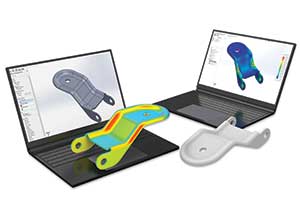Article re-posted with permission from Parker Hannifin Sealing & Shielding Team.
Original content can be found on Parker’s Blog. and was written by Albena Ammann, life science development engineer, Engineered Materials Group.
Have you been frustrated with going through multiple design iterations when rubber components are failing due to high stresses or your device has been leaking due to insufficient compression? Have you lost months and months of precious time having to recut tools and make design changes?
FEA takes out the guesswork
 Finite element analysis (FEA) is an effective tool used in design iterations. It allows for different design ideas, options, and alterations to be quickly, effectively, and precisely compared.
Finite element analysis (FEA) is an effective tool used in design iterations. It allows for different design ideas, options, and alterations to be quickly, effectively, and precisely compared.
Using FEA can improve both the speed and quality of product design as well as reduce the overall cost. Rubber parts, such as silicone diaphragms, septums, seals, valves, tubing, and balloons are critical components in today’s medical devices that can benefit from the use of FEA. It can be an excellent design tool to improve the functional performance of these devices. FEA for rubber products is actually far more complex than for metal or plastic products. It requires sophisticated nonlinear FEA software - such as MSC Marc - as well as a good understanding of the material behavior, material modeling, and testing requirements.
Rubber is highly stretchable, flexible, and durable. This blend of elastic properties differentiates rubber from other materials and makes it one of the best choices for many components in medical devices. However, it’s important to note that rubber materials are not 100 percent elastic because they can develop compression sets and force decay, causing eventual performance degradation and shorter useful life.
Nonlinear FEA for rubber products
Normally, there are three types of nonlinearities encountered: kinematic nonlinearity, material nonlinearity, and boundary nonlinearity. Additionally, rubber products are often subject to large deformations. Whenever material experiences large deformations at least two kinds of nonlinearity - kinematic and material - are involved.
Commonly used nonlinear material models in FEA are elastoplastic models for metals and plastics and hyperelastic models for rubber. in addition, the boundary nonlinearity is usually associated with large deformations.
What are the best test modes to use? One basic engineering rule should apply: always design and perform tests that most closely simulate the actual application conditions that the finished component or device will experience.
Rubbers are almost incompressible
In general, rubber materials are considered nearly incompressible, simply because their volume change is negligible for most applications as a result of that their bulk modulus (105 psi) being several orders larger than their shear modulus (102 psi). The rubber material is actually much more compressible than metal in a confined state (the bulk modulus of typical steel is 107 psi). This understanding is very important to the design considerations of elastomeric products, especially when thermal expansion, limited groove space, or compression of high aspect ratio parts are involved.
Simulation accuracy and relativity
Many factors affect the accuracy and reliability of FEA results, such as material modeling, geometry simplification, and numerical methods. FEA is mostly used in design iterations for which relative comparison is sufficient in the majority of instances. When analysis results are interpreted in a relative sense, different design ideas, options, or modifications can be compared effectively and accurately, and most importantly, rapidly. Furthermore, some tested cases may already exist and can be used as references.
FEA improves product design
FEA is a powerful tool for the development of rubber components for medical devices. The proper use of FEA can minimize physical prototyping and provide for concurrent engineering. It greatly improves both the speed and the quality of product design, as well as provides cost savings.
For more information about finite element analysis or to see if it's right for our application, contact Gallagher Fluid Seals today to speak with an engineer.
